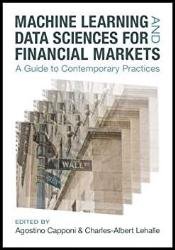 Название: Machine Learning and Data Sciences for Financial Markets: A Guide to Contemporary Practices
Название: Machine Learning and Data Sciences for Financial Markets: A Guide to Contemporary PracticesАвтор: Agostino Capponi, Charles-Albert Lehalle
Издательство: Cambridge University Press
Год: 2023
Страниц: 741
Язык: английский
Формат: pdf
Размер: 66.3 MB
Machine learning, Artificial Intelligence (AI), and Data Science (DS) pervade every aspect of our everyday life. Many of the techniques developed by the Computer Science community are becoming increasingly used in the area of financial engineering, ranging from the use of Deep Learning methods for hedging and risk management through the exploitation of AI techniques for investment or design of trading systems. These techniques are also having enormous implications on the operations of financial markets. It is thus not surprising to see increasingly the proliferation of AI research groups or recently created “AI Labs” at major banks, centered around topics of key relevance to financial services. Those include, among others, explainable AI, human-machine interaction, and DS methods for extracting information from data and using it to support investment decisions. The integration of AI methods in the decision making process may also have unintended or unanticipated consequences especially in a sector like finance, where bad intermediation of risk can spread over the whole economy.
Leveraging the research efforts of more than sixty experts in the area, this book reviews cutting-edge practices in Machine Learning for financial markets. Instead of seeing Machine Learning as a new field, the authors explore the connection between knowledge developed by quantitative finance over the past forty years and techniques generated by the current revolution driven by Data Sciences and Artificial Intelligence. The text is structured around three main areas: 'Interactions with investors and asset owners,' which covers robo-advisors and price formation; 'Risk intermediation,' which discusses derivative hedging, portfolio construction, and Machine Learning for dynamic optimization; and 'Connections with the real economy,' which explores nowcasting, alternative data, and ethics of algorithms. Accessible to a wide audience, this invaluable resource will allow practitioners to include Machine Learning driven techniques in their day-to-day quantitative practices, while students will build intuition and come to appreciate the technical tools and motivation for the theory.
Data-centric methodology, Machine Learning and Deep Learning in particular, can greatly facilitate various computational and modelling tasks in quantitative finance. In this chapter, we first demonstrate how supervised learning can help us implement and calibrate option pricing models that have previously been hard to deploy due to their analytical intractability. Secondly, we illustrate how we can discover optimal hedging strategies and arbitrage-free prices in a model-free fashion via the recent unsupervised deep hedging approach. As the availability of high-quality training samples underpins these data-centric methods, we finally outline recent work in the nascent field of market data generators, which are used to generate realistic, yet synthetic, market data for the training of financial Machine Learning algorithms.
Скачать Machine Learning and Data Sciences for Financial Markets: A Guide to Contemporary Practices